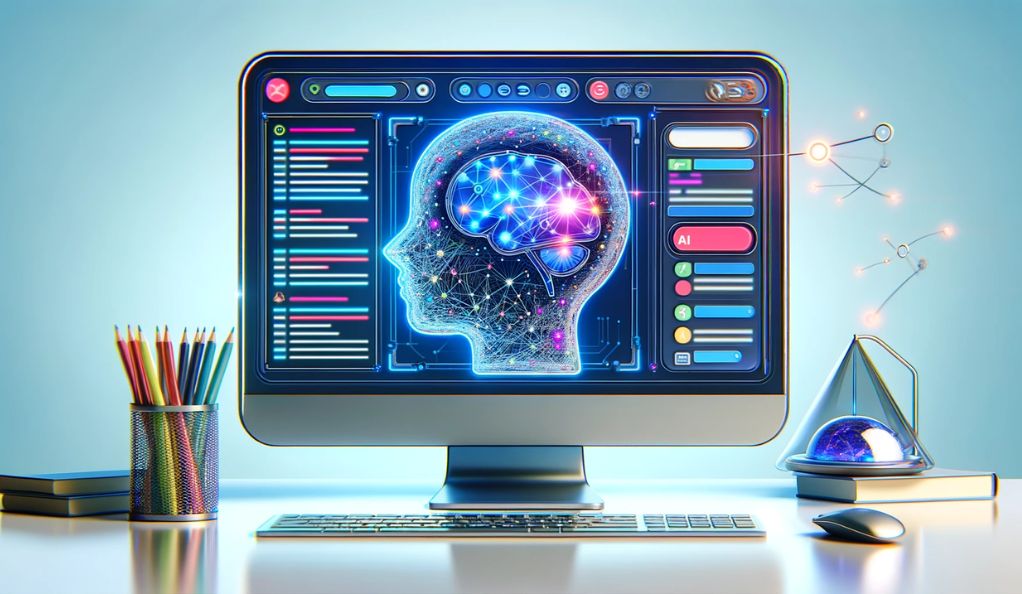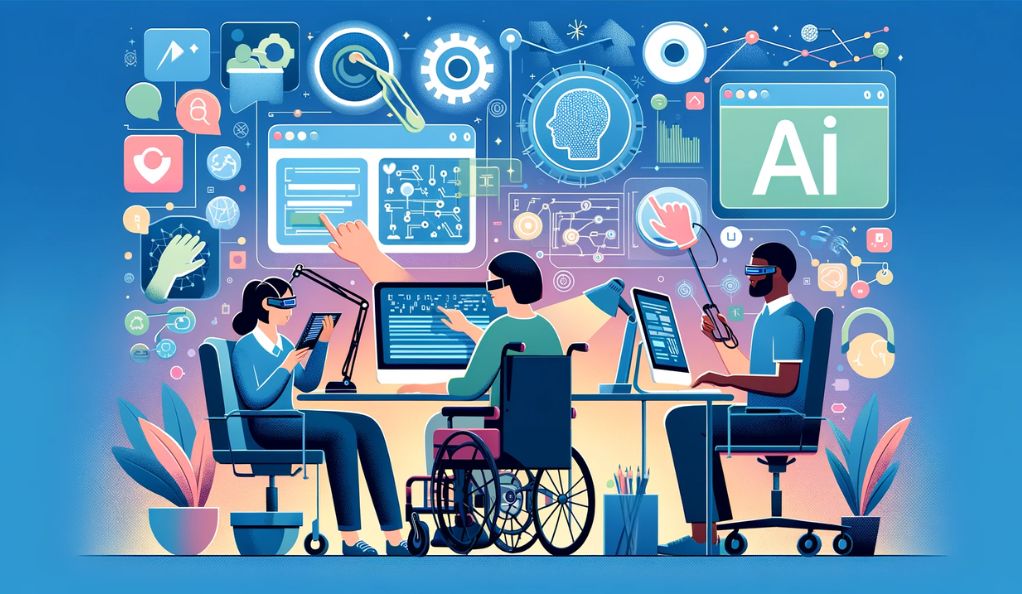In today’s digital landscape, the importance of creating inclusive and accessible apps and websites cannot be overstated. Accessibility is not merely a feature but a fundamental aspect of modern web development, ensuring that individuals of diverse abilities can navigate and interact with digital platforms seamlessly. However, achieving comprehensive accessibility compliance can be a complex and daunting task, often requiring meticulous manual checks and testing processes.
This is where the role of Artificial Intelligence (AI) becomes increasingly pivotal. AI technology has emerged as a powerful tool in automating accessibility compliance checks, significantly streamlining the process and enhancing the overall user experience for individuals with disabilities. By leveraging advanced algorithms and machine learning capabilities, AI has the potential to revolutionize the way developers approach and prioritize accessibility in their digital creations.
Understanding the Importance of Accessibility in Digital Spaces
Accessibility is the cornerstone of inclusivity in the digital realm. It ensures that individuals with varying abilities, including those with visual, auditory, motor, or cognitive impairments, can perceive, understand, navigate, and interact with digital content effectively. By implementing accessible design principles, developers can create user-friendly interfaces that accommodate a wide range of user needs, preferences, and technological constraints.
Role of AI in Enhancing Accessibility Compliance
AI serves as a catalyst in the pursuit of accessibility excellence. With its ability to perform automated and comprehensive accessibility checks, AI technology helps identify potential barriers that could impede the user experience for individuals with disabilities. By analyzing various aspects of digital content, including website layouts, color contrast, text alternatives for images, and keyboard navigation, AI can swiftly pinpoint areas that require adjustments or improvements to meet established accessibility standards.
Moreover, AI-powered solutions enable developers to proactively integrate accessibility measures during the initial stages of web development, mitigating the need for extensive post-development modifications. By integrating AI-driven accessibility testing into the development workflow, teams can efficiently ensure that their apps and websites comply with relevant accessibility guidelines and regulations, fostering an inclusive digital environment for all users.
AI-Driven Accessibility Testing: An Overview

To appreciate the profound impact of AI in the realm of accessibility, it is essential to understand the evolution of AI-driven accessibility testing and its significance. AI-powered accessibility testing, sometimes referred to as automated accessibility testing, represents a departure from traditional manual approaches and offers a more efficient and scalable way to evaluate and address accessibility concerns.
Exploring the Evolution of AI in Accessibility Testing
In the past, ensuring web accessibility predominantly relied on manual testing, which involved experts meticulously inspecting web content to identify potential issues. While this approach was effective, it was time-consuming, labor-intensive, and often prone to human error. It also required a deep understanding of accessibility guidelines, making it inaccessible for developers who were not accessibility experts.
AI has changed the game by introducing automation and intelligence to accessibility testing. The evolution of AI-driven accessibility testing can be summarized as follows:
| AI Techniques | Description |
|---|---|
| Rule-Based Testing | In the early stages of AI-powered accessibility testing, rule-based systems were developed to automatically identify known accessibility issues, adhering to established guidelines like WCAG, to scan web content. |
| Machine Learning | With advancements in AI, machine learning algorithms were introduced to enhance the accuracy and reliability of accessibility testing. These models were trained on extensive datasets, enabling recognition of a wider range of issues. |
| Natural Language Processing (NLP) | NLP techniques are utilized to improve text-related accessibility checks. AI can assess the quality of alternative text for images, content readability, and language appropriateness on web pages. |
| Image Recognition | AI-powered image recognition is pivotal in evaluating non-text content, including images, charts, and graphs. These algorithms analyze visuals to ensure they are described comprehensibly to screen reader users. |
Key Components and Benefits of AI-Driven Accessibility Checks
AI-driven accessibility testing typically encompasses several key components:
- Scanning Tools: These tools automatically analyze web content and provide reports on accessibility issues. They can be integrated into the development workflow or used as standalone solutions.
- Reporting and Remediation: AI tools generate detailed reports that highlight accessibility issues, along with suggestions for remediation. This empowers developers with actionable insights to make necessary improvements.
- Continuous Monitoring: AI can be employed for ongoing monitoring to ensure that web content remains accessible over time, even as updates and changes are made.
The benefits of AI-driven accessibility checks are manifold:
- Efficiency: AI automates the testing process, reducing the time and effort required to identify and address accessibility issues.
- Consistency: AI tools provide consistent results, minimizing the risk of human error and ensuring thorough coverage of accessibility guidelines.
- Cost-Effectiveness: By automating accessibility testing, organizations can save on the costs associated with manual testing and potential legal issues stemming from non-compliance.
- Early Detection: AI facilitates early detection of accessibility issues, allowing developers to address them in the design and development stages, rather than in post-production.
Revolutionizing Inclusive Web Development
The integration of AI tools and technologies has led to a significant transformation in the landscape of inclusive web development. By incorporating AI-driven solutions into the development process, web developers can proactively ensure that their digital products are accessible to a diverse audience, including individuals with disabilities. The following sections highlight the key AI tools and their impact on creating user-friendly and accessible interfaces.
AI Tools and Technologies for Ensuring Accessibility Compliance
AI-driven accessibility testing tools encompass a range of innovative technologies that contribute to a more inclusive digital environment. Some of the prominent AI tools and technologies include:
- Automated Accessibility Testing Software: These tools utilize AI algorithms to scan web content and identify potential accessibility barriers. They provide comprehensive reports and recommendations for resolving issues, enabling developers to make necessary adjustments swiftly.
- Screen Reader Simulation Technology: AI-powered screen reader simulators allow developers to experience web content from the perspective of users who rely on screen readers. This simulation helps identify potential accessibility gaps and optimize the user experience for individuals with visual impairments.
- Voice Recognition and Natural Language Processing (NLP): AI-powered voice recognition and NLP technologies enable the development of voice-activated interfaces and interactive features that cater to users with motor impairments or those who prefer hands-free interaction.
- Image Recognition and Description Generation: AI image recognition technologies aid in generating accurate and descriptive alternative text for images, ensuring that individuals with visual impairments can comprehend the content effectively through screen readers.
Impact of AI on Creating User-Friendly and Accessible Interfaces
The adoption of AI tools has significantly improved the overall accessibility and usability of digital interfaces. By leveraging AI-driven solutions, developers can:
- Enhance User Engagement: AI technologies facilitate the creation of intuitive and user-friendly interfaces that cater to diverse user needs. By understanding user behavior and preferences, AI helps personalize the user experience and optimize engagement.
- Ensure Consistent Accessibility Compliance: AI-powered accessibility testing ensures consistent adherence to established accessibility standards, minimizing the risk of overlooking critical accessibility requirements during the development process.
- Foster Innovation in Design: AI encourages innovation in design by enabling the development of creative and interactive solutions that accommodate various user abilities and preferences. This fosters a culture of inclusivity and creativity in web development.
By embracing AI-driven accessibility testing and incorporating inclusive design principles, developers can foster a digital landscape that promotes equal access and usability for all users, irrespective of their abilities or disabilities.
Automated Accessibility Testing Techniques with AI

In the pursuit of comprehensive accessibility compliance, AI plays a pivotal role in automating the testing process and ensuring that digital content meets the required accessibility standards. By employing various automated accessibility testing techniques powered by AI algorithms, developers can efficiently identify and resolve potential accessibility issues, thereby creating a more inclusive online experience for all users. This section outlines some of the key techniques and methodologies employed in automated accessibility testing with AI.
Assessing Web Content and User Interface with AI Algorithms
AI algorithms are designed to assess web content and user interfaces through a series of comprehensive checks that evaluate various accessibility parameters. Some of the crucial aspects addressed by AI algorithms include:
Semantic Structure Analysis: AI algorithms analyze the semantic structure of web content to ensure that information is organized in a coherent and accessible manner. This analysis helps improve the overall readability and navigability of the content for users with cognitive impairments.
Color Contrast and Visual Clarity: AI algorithms assess color contrast ratios and visual elements to ensure that content remains easily discernible for individuals with visual impairments. This evaluation guarantees that text, images, and other visual elements meet the necessary contrast standards for improved readability.
Keyboard Navigation Compatibility: AI algorithms test the compatibility of web interfaces with keyboard navigation, ensuring that users can navigate through the content seamlessly without relying on a mouse or other pointing devices. This evaluation caters to individuals with motor impairments who rely on keyboard navigation for accessibility.
Streamlining the Process of Identifying and Resolving Accessibility Issues
AI-driven accessibility testing streamlines the identification and resolution of accessibility issues through a systematic and automated approach. By leveraging AI-powered tools, developers can:
| Key Benefits of AI-Driven Accessibility Testing | Description |
|---|---|
| Generate Comprehensive Accessibility Reports | AI tools generate detailed reports highlighting specific accessibility issues, along with actionable recommendations for addressing them. These reports streamline the debugging process and facilitate efficient resolution of accessibility concerns. |
| Facilitate Swift Remediation | AI-driven accessibility testing expedites the remediation process by providing developers with precise insights and guidelines for resolving accessibility issues effectively. This facilitates swift implementation of necessary adjustments, thereby expediting the overall development process. |
AI for Empowering Digital Inclusivity
The integration of AI technologies has ushered in a new era of digital inclusivity, enabling developers to address the diverse needs of users with disabilities through adaptive and user-friendly interfaces. By harnessing the power of AI, developers can create a more accessible and accommodating digital environment, ensuring that individuals with varying abilities can navigate, interact, and engage with digital content seamlessly. This section highlights the transformative role of AI in empowering digital inclusivity and fostering a more inclusive online experience for all users.
Addressing Diverse User Needs through AI-Enabled Adaptive Interfaces
AI-enabled adaptive interfaces cater to the diverse needs of users by dynamically adjusting the digital experience based on individual preferences and requirements. Some of the key features of AI-enabled adaptive interfaces include:
- Personalization and Customization: AI facilitates personalized user experiences by adapting digital interfaces to accommodate individual preferences, such as font size, color themes, and navigation preferences. This personalization enhances user comfort and engagement, especially for individuals with visual or cognitive impairments.
- Context-Aware Interactions: AI technologies enable digital interfaces to interpret user context and adapt the interface accordingly. This feature enhances user interaction by providing relevant and context-specific content, simplifying navigation and information retrieval for users with diverse needs.
- Intuitive Assistive Features: AI-driven assistive features, such as predictive text input, voice recognition, and smart suggestions, empower users with disabilities to interact with digital content more effectively. These features bridge the accessibility gap and facilitate seamless user interactions, irrespective of the user’s abilities.
Ensuring a Seamless User Experience for Individuals with Disabilities
The implementation of AI in digital development significantly contributes to fostering a seamless user experience for individuals with disabilities. By leveraging AI technologies, developers can:
- Enhance Accessibility and Usability: AI-powered adaptive interfaces enhance the accessibility and usability of digital platforms, ensuring that individuals with disabilities can navigate and engage with content effortlessly.
- Promote Equal Access to Information: AI technologies promote equal access to information by providing alternative formats, such as audio descriptions, screen reader compatibility, and voice-guided navigation, for users with visual or auditory impairments.
- Encourage User Empowerment: AI-driven adaptive interfaces empower users with disabilities by enabling them to interact with digital content independently and efficiently. This empowerment fosters a sense of inclusivity and autonomy, promoting a more equitable digital experience for all users.
Future Prospects and Challenges

While AI has already made significant strides in enhancing digital accessibility, the future holds even greater promise for the integration of AI technologies in fostering a more inclusive online environment. However, this trajectory is not without its challenges. Understanding the future prospects and addressing potential obstacles is crucial to leveraging AI’s full potential in furthering digital accessibility. This section explores the future prospects and challenges associated with AI’s role in advancing digital accessibility.
Predicting the Future of AI in Furthering Digital Accessibility
Predicting the future of AI in furthering digital accessibility involves envisioning continued innovation and advancement. This includes the anticipation of enhanced personalization through AI technologies, enabling more tailored digital experiences to accommodate individual user preferences and accessibility needs. The integration of multimodal interfaces seamlessly combining voice, gesture, and touch interactions is also foreseen, fostering intuitive and accessible user experiences.
Furthermore, there is a strong likelihood of greater automation in accessibility testing, streamlining the identification and resolution of accessibility issues with heightened precision and efficiency. Additionally, the expansion of AI-driven assistive technologies is expected, providing advanced solutions for users with diverse disabilities, empowering them to interact with digital content more effectively and independently.
Overcoming Challenges and Enhancing AI Solutions for Comprehensive Accessibility
In the pursuit of comprehensive accessibility, overcoming challenges and enhancing AI solutions is crucial. This involves addressing ethical concerns related to AI implementation, ensuring data privacy, mitigating algorithmic biases, and fostering inclusivity. Additionally, adapting AI solutions to evolving accessibility standards and guidelines is imperative to maintain compliance and inclusivity. Striking a balance between automation and human expertise remains essential, as human insight is necessary to navigate complex accessibility challenges effectively.
Moreover, addressing technological limitations, such as ensuring compatibility with evolving digital platforms and emerging technologies, is vital for seamless integration and functionality. By addressing these challenges, AI solutions can be optimized to foster a more inclusive and accessible digital environment.
Conclusion
The critical role of AI in creating inclusive apps and websites cannot be overstated. By leveraging AI-powered accessibility testing, developers can ensure that their digital products are accessible to users with diverse abilities, fostering a more inclusive and accommodating online environment.
As AI continues to evolve and advance, it will play an increasingly pivotal role in promoting digital inclusivity and bridging the accessibility gap. Embracing AI as a catalyst for positive change, we can pave the way for a more equitable and accessible digital future, where every individual can engage with online content seamlessly, regardless of their abilities or disabilities.




